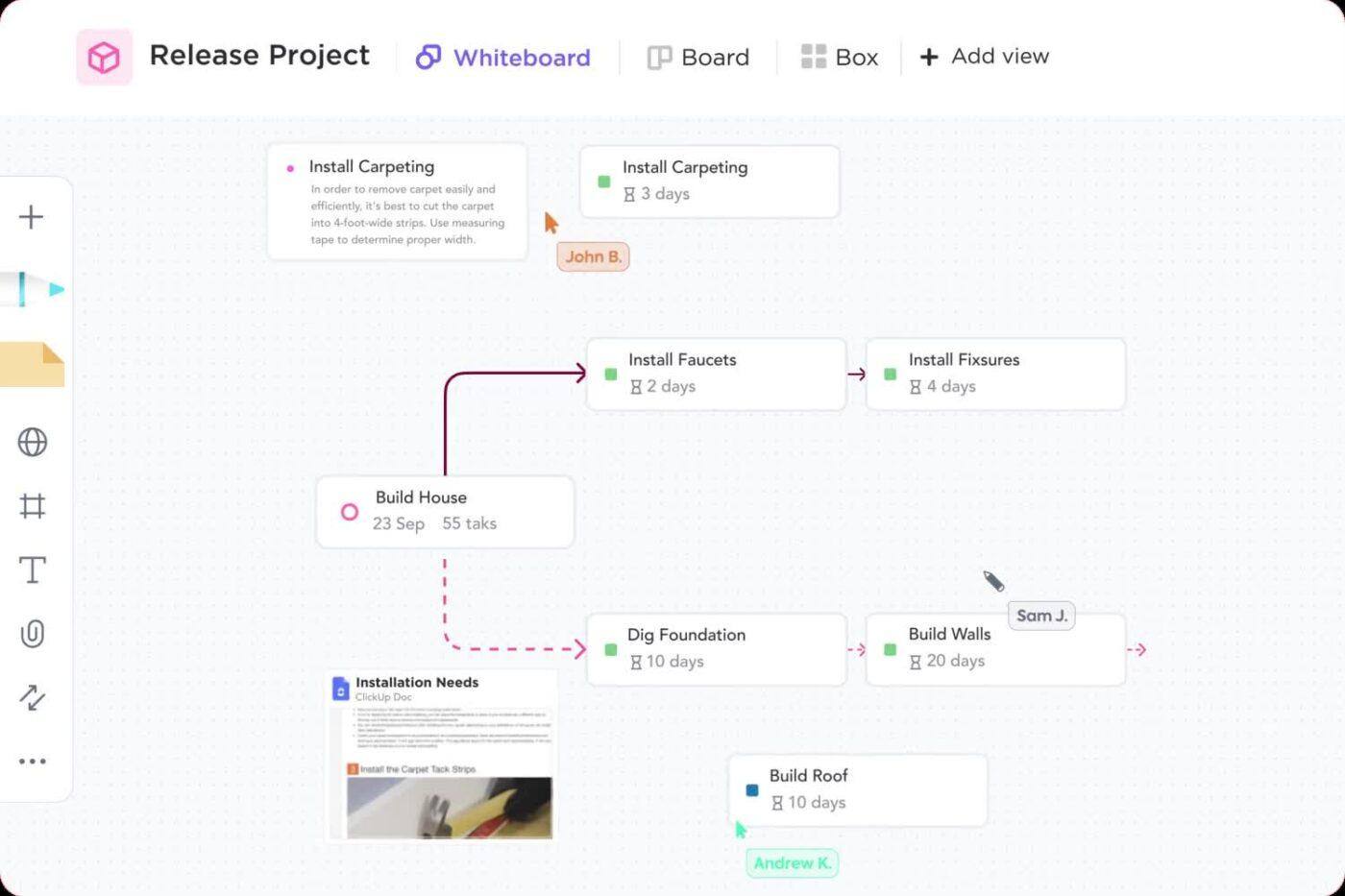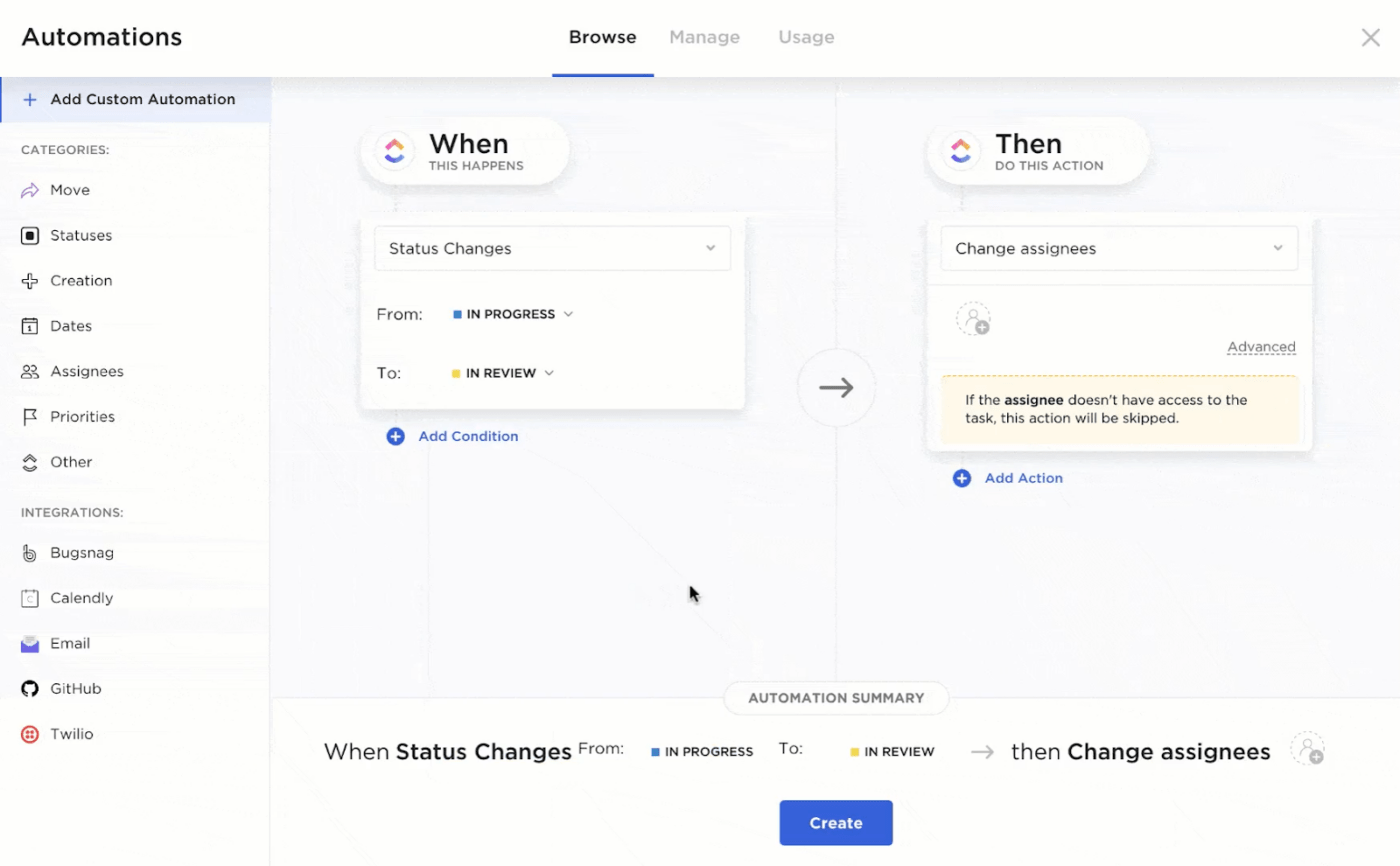ليس كل يوم تغادر اجتماعًا وأنت تشعر بالحماس والوضوح في بنود العمل والدافع لإحداث تأثير كبير. بل على العكس، تشتهر الاجتماعات بأنها تستغرق وقتًا طويلاً وتترك الحاضرين في حالة من الملل أو الارتباك أو الإحباط. 37 مليار دولار تضيع كل عام لاجتماعات غير منتجة. وهذا ثمن باهظ للغاية، خاصة عندما يكون لديك طرق بسيطة لجعل الاجتماعات فعالة. اجتماع فعال هو الاجتماع الذي يكون فيه جدول أعمال محدد، ويدخل المشاركون في صلب الموضوع بسرعة، وتكون قد حددت النتائج المرجوة مسبقًا.
والآن، وبدون مزيد من اللغط، دعنا نستكشف كيف يمكنك جعل اجتماعاتك تعمل بشكل جيد في عام 2024.
سنستعرض الاستراتيجيات، وسنسرد أدوات الذكاء الاصطناعي المفيدة، ونناقش مكونات ونتائج الاجتماعات الرائعة.
فهم نتائج الاجتماعات
تشير نتائج الاجتماع إلى النتائج أو القرارات أو الإنجازات المتوقعة أو المحققة نتيجة الاجتماع. هذه المخرجات هي مخرجات ملموسة وقابلة للتنفيذ تساهم في تحقيق غرض الاجتماع وأهدافه.
يجب أن تتوافق نتائج الاجتماع الفعالة مع الأهداف التنظيمية الأوسع نطاقًا. يجب أن تكون جزءًا من الرؤية الجماعية.
تختلف نتائج الاجتماع حسب نوع الاجتماع والغرض منه، ولكنها غالبًا ما تتضمن عناصر مثل
- القرارات: الاتفاقات أو القرارات التي تم التوصل إليها خلال الاجتماع والتي توجه الإجراءات المستقبلية
- بنود العمل: المهام أو الأنشطة التي تم تكليف الأفراد أو الفرق بها نتيجة لمناقشات الاجتماع
- الخطط: الخطوط العريضة أو الاستراتيجيات الموضوعة لتحقيق أهداف محددة نوقشت في الاجتماع
- تبادل المعلومات: تبادل المعلومات أو التحديثات أو التقارير ذات الصلة بين المشاركين
- حل المشاكل: تحديد المشاكل أو التحديات وحلها من خلال المناقشة التعاونية
- المواءمة: الاتفاق بين أعضاء الفريق على الأهداف أو الأولويات أو الاستراتيجيات
- التغذية المرتدة: جمع المدخلات أو الآراء من المشاركين بشأن مواضيع أو مقترحات محددة
لماذا التركيز على نتائج الاجتماع
الوضوح والتوجيه
توفر النتائج المحددة جيدًا هدفًا واضحًا وخارطة طريق واضحة لما يجب القيام به بعد الاجتماع، مما يضمن أن يكون الجميع على نفس الصفحة ويتحركون في نفس الاتجاه.
المساءلة
عندما تُختتم الاجتماعات بنتائج ومسؤوليات ومواعيد نهائية محددة يتم تعزيز ثقافة المساءلة والمتابعة.
تعزيز الإنتاجية
نتائج الاجتماعات الفعالة توفير الوقت والموارد من خلال منع الحاجة إلى اجتماعات المتابعة لتوضيح النقاط أو القرارات.
تعزيز التواصل
تخلق الاجتماعات الفعالة بيئة مشجعة للتواصل والعمل الجماعي. لا يوجد مجال للغموض عندما يتم توصيل النقاط والقرارات الرئيسية بفعالية.
مواءمة الأهداف
تساعد نتائج الاجتماعات على مواءمة جهود الفريق مع الأهداف التنظيمية الأوسع نطاقًا، مما يضمن أن كل اجتماع يساهم في الصورة الأكبر.
الإدارة الفعالة للاجتماعات هي المفتاح لتحقيق هذه النتائج، وهي عملية مبسطة بواسطة حلول برمجية متقدمة.
ما الذي يجعل الاجتماع ناجحًا؟
لجعل مختلف أنواع الاجتماعات ذات أهمية حقيقية، خطط مسبقًا وأثبت هذه المكونات الرئيسية التي تحول تلك التجمعات الروتينية إلى جلسات مليئة بالطاقة. دعنا نفصلها لك.
1. أهداف الاجتماع
عندما لا يكون الفريق متأكدًا من مهامه، فإن ذلك يسبب الارتباك ويضيع الوقت. بعد الاجتماع، يجب على الأعضاء معرفة ما يجب القيام به ولماذا ومتى، مما يؤدي إلى انخفاض الروح المعنوية والإحباط.
لذا، من المهم تحديد أهداف الفريق أو اجتماع فردي . أثناء القيام بذلك، يجب عليك التأكد من أنها مثمرة وهادفة. ويتضمن تحديد هدفك والنتائج المرجوة - اتخاذ القرارات أو التخطيط للمشاريع أو توليد الأفكار.
هذه الأهداف بمثابة خارطة طريق للمناقشة، وتوجيه المشاركين نحو نتائج قابلة للتنفيذ وتوفير مقياس لنجاح الاجتماع. إنه أمر بالغ الأهمية لجعل اجتماعاتك مركزة وفعالة ومؤثرة.
على سبيل المثال، إذا كنت تخطط لإطلاق منتجك وتخطط لإطلاق منتجك وتسعى إلى تحديد المسار، فإن هدفك هو وضع جدول زمني للمشروع، وتوزيع المسؤوليات، وتحديد قناة اتصال باستخدام فريق العمل و نماذج الاجتماعات الفردية .
تأكد من أن كل شخص يغادر الاجتماع يعرف بالضبط ما يجب العمل عليه لتحقيق الأهداف المحددة. يساعدهم ذلك أيضًا على فهم عمل أعضاء الفريق الآخرين، مما يؤدي إلى مزيد من الشفافية والمساءلة.
ولحسن الحظ، فإن تعدد برنامج إدارة الاجتماعات متوفرة اليوم لضمان نجاح اجتماعك.
2. بنود العمل
بنود العمل هي قائمة مهام ما بعد الاجتماع. إنها المهام أو القرارات أو المسؤوليات الملموسة التي يتم توزيعها، مما يضمن معرفة كل شخص لدوره وإحراز تقدم.
زوِّد كل عضو من أعضاء الفريق بالمعلومات والموارد اللازمة، وأنشئ جدولاً زمنياً مع المسؤوليات الموكلة لأعضاء الفريق المحددين. استخدم أدوات مثل مخطط جانت أو ورقة إكسل لتنظيم أفضل. يمكنك أيضًا تعيين عناصر العمل داخل جدول أعمال الاجتماع مع تواريخ الاستحقاق
3. متابعة الاجتماع
إن التحقق من بنود العمل وتتبع التقدم المحرز وضمان التزام الجميع بالتزاماتهم بعد ذلك يحافظ على استمرار الزخم الناتج عن الاجتماع الناجح.
يعتمد نجاح الاجتماع على مدى مشاركة الجميع، ومدى كفاءة اتخاذ القرارات، ومدى فعالية تحويل أهداف الاجتماع إلى إجراءات بعد ذلك.
مكونات نتائج الاجتماعات الرائعة
يتطلب تحويل الاجتماعات العادية إلى جلسات من الإنتاجية واتخاذ القرارات نهجًا استراتيجيًا. وينطوي مخطط النجاح على عدة مكونات هامة، يلعب كل منها دورًا محوريًا في تشكيل الاجتماعات بفعالية.
من خلال التركيز على هذه المكونات لنتائج الاجتماعات، يمكنك التأكد من أن كل اجتماع لا يحقق الأهداف المرجوة منه فحسب، بل يساهم أيضًا بشكل إيجابي في تحقيق الأهداف الأوسع لفريقك وشركتك.
- مواءمة الأهداف: يبدأ كل اجتماع مثمر بأهداف واضحة. في نهاية الاجتماع، يجب أن يكون أعضاء الفريق متفقين على هدف الاجتماع والخطوات التالية
- تحديد الأدوار والمسؤوليات: توضيح دور كل مشارك للحد من التداخل وتعزيز المساءلة. هذا الوضوح ضروري لضمان فهم أعضاء الفريق لمسؤولياتهم ومساهمتهم بفعالية في تحقيق هدف الاجتماع
- عناصر عمل ملموسة ومواعيد نهائية محددة: عندما يتم تحديد مهام محددة بمواعيد نهائية، فإن ذلك يدفع الزخم ويساعد على إبقاء الفريق على المسار الصحيح لإنجازها في الوقت المناسب
- الانخراط والمشاركة وحل المشكلات: تشجيع الأسئلة المفتوحة لتعزيز بيئة تعاونية وجمع مدخلات متنوعة. قد تؤدي جلسات العصف الذهني للفريق إلى حلول إبداعية للمشاكل. هذا التنوع في الأفكار يمكن أن يثري نتائج اجتماعاتك بشكل كبير
- توثيق النتائج الرئيسية: يجب تسجيل النقاط والقرارات الرئيسية للرجوع إليها في المستقبل. إن ضمان وصول جميع أعضاء الفريق إلى هذه المعلومات أمر بالغ الأهمية للحفاظ على التوافق بعد الاجتماع. الدقةمحاضر الاجتماعات جزء لا يتجزأ من هذه العملية
- خطة المتابعة وتتبع التقدم المحرز بشكل منتظم: تنفيذ نظام لمتابعة بنود العمل. تعد عمليات التحقق المنتظمة وتتبع التقدم المحرز ضرورية للحفاظ على الزخم وتكييف الاستراتيجيات حسب الحاجة
- تقييم فعالية الاجتماع: بعد الاجتماع، قم بتقييم مدى تحقيق الأهداف. هذه الممارسة الانعكاسية ضرورية للتحسين المستمر لاستراتيجيات الاجتماعات
خطوات تحسين نتائج الاجتماعات
اتبع هذه الخطوات المدعومة من الخبراء لتحسين نتائج اجتماعاتك.
الخطوة 1: ضع جدول الأعمال
يوفر وضع جدول أعمال واضح خارطة طريق، مما يضمن معرفة الجميع بما يمكن توقعه واستعدادهم مسبقًا.
استخدم ميزة اجتماعات Clickup لإنشاء جدول أعمال الاجتماع ومشاركته مع جميع أعضاء الفريق. وتتيح لك إنشاء قوائم مراجعة يمكنك وضع علامات عليها أثناء الاجتماع مع تقدم المناقشة.
يمكنك أيضًا إضافة وتعيين تعليقات لأي تبعيات عند الحاجة. بالإضافة إلى ذلك، إنها أداة رائعة لتدوين ملاحظات الاجتماع وإتاحتها مركزياً.

قم بتدوين الملاحظات، وتتبع جدول الأعمال، وتعيين عناصر العمل لفريقك باستخدام ميزة اجتماعات ClickUp
مع وجود جدول أعمال محدد جيدًا، تظل المناقشات مركزة ويتم استخدام الوقت بكفاءة. كما تتيح للمشاركين المساهمة الفعالة في تقديم اقتراحاتهم، مما يؤدي إلى اجتماعات أكثر نجاحًا وإنتاجية.
الخطوة 2: تحسين الجدولة الزمنية
اختر الأوقات التي يكون فيها المشاركون أكثر تفرغاً وتركيزاً. اختر التاريخ والوقت قبل وقت كافٍ، مستهدفًا الحد الأدنى من تعطيل يوم العمل. يضمن لك وقت مبكر في الصباح الباكر أو قبل الغداء مباشرةً مشاركة وإنتاجية أفضل.
استخدم أدوات مثل التقويمات أو تطبيقات الجدولة لتسهيل العملية. عرض تقويم ClickUp يمنحك ملعبًا مرئيًا لجدولة خالية من الإجهاد. ضع جدول أعمالك، ونسق المواعيد، وقم بإدارة الحضور دون عناء.
تتيح لك ميزة السحب والإفلات البسيطة إسقاط مهامك بسرعة على التقويم. لمزامنة العمل، يمكنك حتى مشاركة هذه المهام على تقويم ClickUp مع زملائك.
بالإضافة إلى ذلك، يمكن لـ ClickUp إرسال تذكيرات بالمهام والاجتماعات المعلقة أو القادمة، حتى لا تفوتك هذه المهام مرة أخرى!

عرض الأحداث التي تمت مزامنتها من تقويم Google في طريقة عرض تقويم ClickUp
الخطوة 3: تجنب فقدان أي تفاصيل
هل تخشى أن تفوتك أنت أو زملاؤك في الفريق تفاصيل الاجتماعات المهمة؟ تأكد من تسجيل الاجتماعات. من خلال تسجيل المناقشات، فإنك تضمن استرجاع معلومات دقيقة، وتقلل من مخاطر السهو، وتعزز نتائج كل اجتماع. ميزة ClickUp's Clip الخاصة بـ ClickUp هي ما تحتاجه لحفظ التسجيلات للرجوع إليها في المستقبل ومشاركتها مع أي شخص باستخدام رابط عام.
تعمل هذه الممارسة على تعزيز الوضوح والمساءلة والقدرة على إعادة النظر في النقاط المهمة، مما يساهم في نهاية المطاف في عقد اجتماعات أكثر فعالية ونجاحاً.

التقاط تسجيلات الاجتماعات ومشاركتها من خلال ميزة ClickUp's Clip في ClickUp
الخطوة 4: لخص مثل المحترفين
قسّم المعلومات المعقدة إلى نقاط واضحة وتأكد من أن الجميع على نفس الصفحة. تحافظ هذه الممارسة على تركيز المناقشات وتساعد الجميع على اتخاذ قرارات أفضل. ClickUp AI يكثف المناقشات في شكل لقيمات صغيرة الحجم. إنها أداة أساسية أداة الذكاء الاصطناعي للاجتماعات التي لا تدع أي نقاط حيوية تضيع في المناقشة.
يضمن ذلك أيضاً عدم استبعاد أعضاء فريقك الذين لم يتمكنوا من حضور الاجتماع من القرارات الرئيسية وبنود العمل التي تم الانتهاء منها خلال الاجتماع.
يعمل تطبيق ClickUp AI كسكرتير شخصي لك طوال الاجتماع، حيث يقوم بتدوين المؤشرات الهامة حتى تتمكن من التركيز على التنفيذ وليس التوثيق، وبالتالي التخلص من انشغالك بالعمل.

تلخيص محضر اجتماع باستخدام ClickUp AI
الخطوة 5: العصف الذهني بشكل إبداعي
شجع الأفكار المتنوعة والتعاون المفتوح لتحفيز الابتكار. عندما يشعر أعضاء الفريق بالراحة في مشاركة الحلول الإبداعية، تصبح الاجتماعات ديناميكية وموجهة نحو الحلول، مما يؤدي إلى نتائج أفضل.
يمكنك جعل الاجتماعات ممتعة ومثمرة باستخدام العديد من تقنيات العصف الذهني . اللوحات البيضاء لـ ClickUp هي إحدى الأدوات التي ستكون مفيدة أثناء العصف الذهني. فهي تتيح لك تصور المفاهيم مع فريقك، بغض النظر عن مستوى إبداعهم، مما يجعل التواصل أسهل وأكثر متعة.
وبفضل ميزة السحب والإفلات، يمكنك التعاون في الوقت الفعلي لتخطيط سير العمل وخرائط الطريق. كما تتيح لك رسم رسومات تقريبية أو تحميل الوسائط لإنشاء لوحة الأفكار.

تصوَّر المفاهيم بشكل أفضل باستخدام اللوحات البيضاء من Clickup
الخطوة 6: إعطاء هيكل لاجتماعك
عندما يكون للاجتماعات هيكل محدد، تسير الأمور بسلاسة، وتصبح المناقشات أكثر منطقية، وتصبح النتيجة أكثر نجاحًا.
تساعد قوالب الاجتماعات على تبسيط المهام المتعلقة بتنظيم الاجتماع من خلال توفير إطار عمل الاجتماع وقائمة مرجعية للعناصر التي ستتم مناقشتها، مما يضمن عدم حدوث أي شيء يفلت من بين يديك. قالب الاجتماع الخاص بـ ClickUp يضمن لك بدء اجتماعاتك بهدف واضح. فهو يتيح لك إدارة اجتماعاتك بشكل أفضل مما يمنعك من الخروج عن الموضوع.
نظّم جدول أعمال الاجتماعات، والملاحظات، والمتابعة على قالب اجتماعات ClickUp
قالب محضر الاجتماعات من ClickUp يساعدك على تسجيل الحضور ووضع علامات على الحضور، وتدوين ملاحظات مفصلة لكل بند من بنود جدول الأعمال، وتنظيم بنود العمل. باختصار، يوفر هذا القالب المخطط المثالي لتلخيص اجتماع ناجح.
إنشاء هيكل متين للاجتماعات والحفاظ عليه باستخدام قالب محضر اجتماعات ClickUp
يساعد هذا القالب أعضاء الفريق على البقاء مسؤولين عن عملهم. فهو يحدد الموضوعات والأهداف والغايات والأهداف، ويقسم المهام وعناصر العمل، ويحدد المسؤوليات لأعضاء الفريق المعنيين.
الخطوة 7: أتمتة عناصر العمل
قم بإعداد أدوات لتدوين ما حدث في الاجتماع تلقائيًا، وإنشاء قوائم المهام، ومشاركة الملخصات مع الفريق.
قم بإدارة مهام المتابعة دون عناء باستخدام أتمتة ClickUp . استخدمها لتعيين الإجراءات مثل نقل الحالات، وتغيير التواريخ، وتخصيص المهام لكل عضو، وتوثيق محاضر الاجتماعات تلقائيًا، مما يبقي الجميع على المسار الصحيح دون عناء يدوي.

ضبط شروط الأتمتة وتجنب العمل الروتيني اليدوي باستخدام ClickUp Automation
الخطوة 8: تحليل نجاح الاجتماع
يسمح لك تحليل مقاييس ما بعد الاجتماع بتقييم الأداء، وفهم ما الذي سار على ما يرام، وتحديد مجالات التحسين. تكتسب ميزة استراتيجية للاجتماعات المستقبلية من خلال التعمق في هذه الأرقام.
تقدم تحليلات اجتماعات ClickUp رؤى حول فعالية الاجتماعات. يمكنك قياس مقاييس مثل الحضور، ومستويات المشاركة، والوقت المستغرق، والتي تقدم رؤى قيمة.
استخدم قالب ملاحظات اجتماع محلل البيانات ClickUp Data Analyst Meeting Notes لتصور الرؤى باستخدام المخططات والرسوم البيانية، وتسجيل القرارات الحاسمة، والرجوع إلى المناقشات السابقة عند الحاجة.
توثيق الرؤى الأساسية من خلال نموذج ملاحظات اجتماع محلل البيانات ClickUp Data Analyst Meeting Notes
ادمج هذه الخطوات مع ميزات ClickUp وحوّل اجتماعاتك من اجتماعات روتينية إلى جلسات مؤثرة.
أمثلة من العالم الحقيقي لنتائج الاجتماعات
لنلقِ نظرة على أمثلة واقعية توضح كيف تتحول مناقشات الاجتماعات إلى خطوات وقرارات عملية.
تغطي هذه الأمثلة التسويق واستراتيجية العمل وتعاون الفريق.
استراتيجية حملة التسويق
حدد من سيقوم بماذا للحملة الكبيرة التالية - بدءًا من تحديد الجمهور المستهدف إلى تعيين مهام إنشاء الإعلانات ونشر الكلمة. فيما يلي النتائج المحتملة من اجتماعات التسويق.
- استراتيجية الحملة: وضع اللمسات الأخيرة على خطة شاملة لحملة التسويق القادمة
- مراجعة الأداء: تقييم نتائج الحملة، وتحديد مجالات التحسين، وتخطيط استراتيجيات التحسين
- تخطيط المحتوى: وضع تقويم للمحتوى للربع القادم مع تحديد المسؤوليات المحددة
- استراتيجية وسائل التواصل الاجتماعي: تحديد نهج التسويق عبر وسائل التواصل الاجتماعي واختيار المنصات وتحديد استراتيجيات المحتوى
- إطلاق المنتج: تخطيط الأنشطة التسويقية لإطلاق المنتج القادم، بما في ذلك القنوات والجداول الزمنية
- أبحاث السوق وتحليل الاتجاهات: مناقشة اتجاهات السوق ومشاركة الرؤى وصياغة توصيات قابلة للتنفيذ
- تخصيص الميزانية: تخصيص ميزانية التسويق للربع، وتبرير المخصصات بناءً على النتائج المتوقعة
- التعاون مع فريق المبيعات: مواءمة جهود التسويق مع أهداف المبيعات، ومناقشة استراتيجيات توليد العملاء المحتملين
- ورشة عمل رسائل العلامة التجارية: تحسين ومواءمة رسائل علامتك التجارية، ووضع مبادئ توجيهية متسقة
- تخطيط التعاون مع المؤثرين: تخطيط التعاون مع المؤثرين وتحديد المؤثرين المناسبين وتحديد تفاصيل الحملة
اجتماع انطلاق المشروع
ضع خطة للمشروع - ما الذي يجب القيام به ومتى ومن سيقوم به. لذا، بحلول نهاية الاجتماع، يكون الجميع على دراية بمهامهم. فيما يلي النتائج المحتملة من اجتماعات بدء المشروع.
- مناقشة أهداف المشروع: تحديد أهداف المشروع بوضوحأهداف المشروع وتعيين الأدوار
- تعيين المهام والجدول الزمني: تخصيص المهام وتحديد الجداول الزمنية وتعيين المسؤوليات
- تخطيط الموارد: تحديد الميزانية والقوى العاملة والأدوات اللازمة للمشروع
- تقييم المخاطر والتخفيف من حدتها: تحديد المخاطر وتخطيط استراتيجيات التخفيف من حدتها
- بروتوكولات التواصل: إنشاء قنوات تواصل واضحة وقنوات للتغذية الراجعة
- مواءمة أصحاب المصلحة: ضمان التوافق مع توقعات أصحاب المصلحة
- التقنية والأدوات: تعريف الفريق بأدوات المشروع وتقنياته
- معايير الجودة ومقاييسها: تحديد معايير الجودة ومقاييس الأداء
- إجراءات التوثيق: وضع إجراءات لتوثيق المشروع
- الخطوات التالية والملاحظات الختامية: تلخيص النقاط الرئيسية وتحديد الخطوات التالية الفورية وتقديم الملاحظات الختامية
اجتماع إطلاق المنتج
فرز جميع التفاصيل الخاصة بإطلاق شيء جديد - كيفية الترويج له، ومقدار ما تريد بيعه، وكيفية الحفاظ على اهتمام العملاء. فيما يلي أهم نتائج اجتماعات إطلاق المنتج.
- استراتيجية الإطلاق: مناقشة كيفية الترويج للمنتج الجديد بفعالية
- أهداف وغايات المبيعات: تحديد أرقام المبيعات المطلوبة وتحديد الأهداف
- خطة إشراك العملاء: التخطيط لكيفية الحفاظ على اهتمام العملاء وتفاعلهم مع المنتج الجديد
جلسة تخطيط استراتيجي ربع سنوية/سنوية
فكّر في المكان الذي تريد أن تكون فيه على المدى الطويل، وتحدث عما يحدث في السوق، وضع خططاً لدعم وإنشاء أشياء مبتكرة. يمكن أن يكون لجلسات التخطيط الخاصة بك النتائج المحتملة.
- رؤية طويلة المدى: ناقش الأهداف والرؤية طويلة المدى للمؤسسة
- تحليل السوق: تحليل اتجاهات السوق ومناقشة تأثيرها على الأعمال التجارية
- التخطيط الابتكاري: وضع خطط لتقديم مبادرات مبتكرة
زيادة إنتاجية الاجتماعات إلى أقصى حد باستخدام ClickUp
لإنجاح نتائج اجتماعاتك، من الضروري التخطيط لإنجاح اجتماعاتك. فكّر في الاجتماعات السابقة التي تركت أثراً إيجابياً، وفكّر في الطريقة التي تريد أن يشعر بها فريقك بعد الاجتماع.
اسأل، "ما هي أهداف الاجتماع؟ سيرشدك هذا السؤال في التخطيط للخطوات اللازمة لتحقيق أهدافك التنظيمية. يضمن التخطيط نتائج اجتماع أكثر فعالية وإرضاءً لجميع المشاركين. وتذكر متابعة كل بند من بنود العمل لتحقيق نتائج الاجتماع!
سيساعدك ClickUp في تخفيف العبء من خلال ميزات مثل الاجتماعات والتقويم والمقطع، بالإضافة إلى قوالب متعددة، لضمان أن التخطيط للاجتماعات وتحقيق نتائج الاجتماعات أسهل من أي وقت مضى. اشترك في ClickUp لضمان نجاح نتائج الاجتماعات.
الأسئلة الشائعة الشائعة
1. ما هي نتائج الاجتماعات الجيدة؟
نتائج الاجتماعات الجيدة هي النتائج الملموسة والقابلة للتنفيذ التي يتم تحقيقها بعد الاجتماع. وتتميز هذه النتائج بأهداف واضحة تم تحقيقها أثناء المناقشة، وبنود عمل محددة تم تعيينها، وخطط متابعة موثقة، وتقييم لفعالية الاجتماع.
2. كيف يمكنني تحسين نتائج اجتماعاتي؟
ينطوي تحسين نتائج الاجتماعات على عدة استراتيجيات رئيسية:
- تحديد أهداف واضحة: تحديد أهداف محددة لكل اجتماع لتوجيه المناقشات نحو نتائج قابلة للتنفيذ
- تعيين مهام قابلة للتنفيذ: تفويض المسؤوليات وبنود العمل للأفراد بعد الاجتماع للمساءلة والتقدم المحرز
- تنفيذ المتابعة الفعالة: مراجعة بنود العمل وتتبع التقدم المحرز وضمان الوفاء بالالتزامات التي تم التعهد بها خلال الاجتماع
- تقييم فعالية الاجتماع: قياس مدى نجاح الاجتماع في تحقيق الأهداف المرجوة منه والنتائج المفيدة التي تم تحقيقها
من خلال تنفيذ هذه الاستراتيجيات في إطار عمل اجتماعاتك وإدارة الاجتماعات باستخدام ClickUp، يمكنك أن تجعلها فعّالة، وتعزز مهاراتك وإنتاجيتك، وتحقق نتائج أكثر تأثيراً.
3. هل يمكن أن يساعدك ClickUp في تحسين نتائج الاجتماعات؟
بالتأكيد! تقدم ClickUp العديد من الميزات المصممة لتحسين فعالية الاجتماعات.
- قوالب جداول أعمال الاجتماعات: قوالب وجداول أعمال منظمة تضمن بدء الاجتماعات بشكل صحيح والحفاظ على تركيزها
- التشغيل الآلي الذكي للمهام: أتمتة مهام المتابعة دون عناء، مما يضمن المساءلة والتقدم دون جهد يدوي
- تحليلات الاجتماعات: استخدم مقاييس الاجتماعات للحصول على رؤى حول مستويات المشاركة والمدة والحضور، مما يسمح لك بتقييم الفعالية وإجراء تحسينات مستنيرة




